|

A Wonderful Experience
MARIA NOCKIN visits Santa Fe
for operas by Verdi, Mozart, Britten and Handel,
plus the first American performance of
Kaija Saariaho's 'Adriana Mater'
The Santa Fe Opera is a major United States company that presents opera in the mountains outside of the famous 'City Different'. Since its auditorium is open at the sides, performances cannot start until the sun has set, but weather occurrences like thunder and lightening can be part of the show. During the time between 4 and 8 August 2008, the company presented Verdi's Falstaff, Mozart's The Marriage of Figaro, Britten's Billy Budd, Handel's Radamisto and the American première of Kaija Saariaho's Adriana Mater.
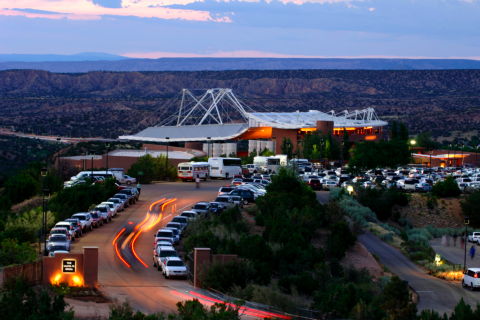
Santa Fe Opera's auditorium. Photo courtesy of Santa Fe Opera
|
Arrigo Boito's libretto for Falstaff is drawn from Shakespeare's Merry Wives of Windsor and includes some materials from his Henry IV, Parts I and II. The opera was first seen at La Scala in Milan on 9 February 1893. Boito once said of it: 'We have all the juice from the Shakespearean orange without any of the seeds'. That certainly was the case in Santa Fe.
Verdi had a bad experience with his first comic opera, Un giorno di regno, which was premièred in 1840. Not until fifty-three years later did he produce another comedy. He said he wanted Falstaff to be a character study and, in the right hands, the title character is an amusing, lovable rogue. The Santa Fe Falstaff, directed by Kevin Newbury and portrayed by British baritone Anthony Michaels-Moore, was exactly that kind of production.
Allen Moyer's inventive scenery established appropriate settings and Claire Mitchell's costumes clearly defined the era. The lighting by Duane Schuler was subtle but effective and created the right atmosphere for each scene. Italian conductor Paolo Arrivabene made his American début with this production. His tempi were sensible and he exerted good control over his players most of the time. Occasionally, however, he let the brass play as loudly as they pleased and as a result they sometimes drowned out the voices.
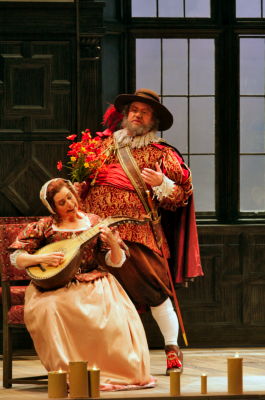
Claire Rutter as Alice Ford and Anthony Michaels-Moore as Sir John Falstaff in Verdi's 'Falstaff' at Santa Fe Opera. Photo © 2008 Ken Howard
|
Claire Rutter was a charming Alice Ford with a lustrous voice while Franco Pomponi was an officious and jealous husband who had a robust sound. Kelly O'Connor was a sonorous Meg Page and Nancy Maultsby a delightfully energetic Mistress Quickly with ringing low notes. Keith Jamison and Wilbur Pauley sang with strong voices and proved to be thoroughly amusing as Falstaff's friends Pistol and Bardolph. As Dr Caius, Corey Bix was appropriately awkward and Laura Giordano was a pretty, but soft-voiced Nanetta. The weakest link in this chain was the Fenton of Norman Reinhardt. He looked dashing but sang with an unexplained hesitancy.
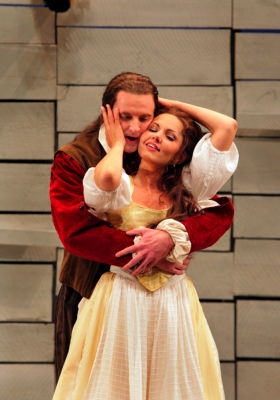
Norman Reinhardt as Fenton and Laura Giordano as Nannetta in Verdi's 'Falstaff' at Santa Fe Opera. Photo © 2008 Ken Howard
|
On the following evening, we were treated to a superb performance of Wolfgang Amadeus Mozart's The Marriage of Figaro. For this one performance, assistant conductor Robert Tweten took over from Maestro Kenneth Montgomery and the orchestra played with lucidity and verve under his leadership. Director Jonathan Kent told the story as clearly as possible, considering it's twists and turns. Paul Brown's scenic design and costumes placed everyone firmly in the eighteenth century, while Duane Schuler's lighting added to the atmospheric ambiance.
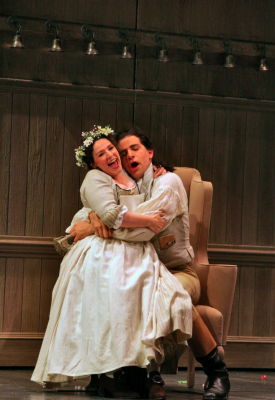
Elizabeth Watts as Susanna and Luca Pisaroni as Figaro in Mozart's 'The Marriage of Figaro' at Santa Fe Opera. Photo © 2008 Ken Howard
|
Tall, charismatic Venezuelan bass-baritone Luca Pisaroni was a powerful Figaro. He commanded the stage and sang with resounding burnished bronze tones. If he is not a superstar already, he certainly is on his way. His Susanna, cute and perky Elizabeth Watts from the United Kingdom, sang sweetly and had the stamina for one of the longest roles in opera. Polish star baritone Mariusz Kwiecien was a cunning count who sang with a smooth masculine legato.
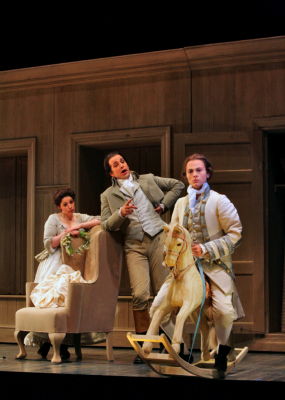
Elizabeth Watts as Susanna, Luca Pisaroni as Figaro and Isabel Leonard as Cherubino in Mozart's 'The Marriage of Figaro' at Santa Fe Opera. Photo © 2008 Ken Howard
|
Susanna Phillips was a smart, creamy-voiced countess who occasionally let us into her private sorrow. The Cherubino was the critically acclaimed Isobel Leonard and she lived up to her excellent reputation for beautiful singing. As the elderly couple who turn out to be Figaro's parents, Dr Bartolo and Marcellina, Gwynne Howell and Michaela Martens showed what can be done to make cameo roles come alive. Tenor Aaron Pegram, also, created a fine portrayal as Don Basilio.
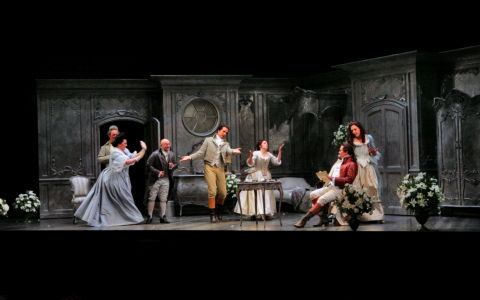
Gwynne Howell as Dr Bartolo, Michaela Martens as Marcellina, Aaron Pegram as Don Basilio, Luca Pisaroni as Figaro, Elizabeth Watts as Susanna, Mariusz Kwiecien as Count Almaviva and Susanna Phillips as the Countess in Mozart's 'The Marriage of Figaro' at Santa Fe Opera. Photo © 2008 Ken Howard
|
Some of the smaller parts were played by apprentices: Kyle Albertson was an amusingly inebriated Antonio. As his daughter, Barbarina, Jamie-Rose Guarrine sang her aria with clear tones. The most interesting apprentice, however, was tenor Alex Mansoori whose acting and singing were both outstanding.
E M Forster and Eric Crozier wrote the text for Benjamin Britten's opera, Billy Budd, basing it on Herman Melville's novel, Billy Budd, Foretopman. Since the action took place on an eighteenth century British warship, all the singers were male. In this work, the casting of the title role is of maximum importance, but in the Santa Fe performance on 6 August, New Zealand baritone Teddy Tahu Rhodes was more than up to the task. With seeming ease, he climbed the stage ship's real rope ladders to perilous heights and sang gloriously from above the heads of others in the cast!
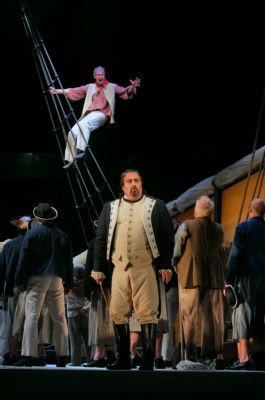
Teddy Tahu Rhodes as Billy Budd and Peter Rose as Claggart in Britten's 'Billy Budd' at Santa Fe Opera. Photo © 2008 Ken Howard
|
Paul Curran's direction brought the work's sad story home with the aid of a wonderfully realistic sailing ship and appropriate costumes designed by Robert Innes Hopkins. Conductor Edo de Waart drew clear and accurate playing from the orchestra and the tension was always tight. William Burden was a lyrical Captain Vere who moved well on stage, while dramatic bass-baritone, Peter Rose, created an unforgettable portrait of the hate filled John Claggart.
Veteran baritone Richard Stilwell was a splendid Mr Redburn, Timothy Nolen was an unwavering Mr Flint, and Lucas Meachem sang the part of Donald with vocal acumen. As Dansker, one of the few admirable characters in the show other than Billy himself, Thomas Hammons drew a memorable characterization. Keith Jameson was a worthy Novice. Tenors Matthew Tuell and John Dykers explored all the facets of their roles as Maintop and Red Whiskers while bass baritone John Stephens was a stentorian Mr Ratcliffe.
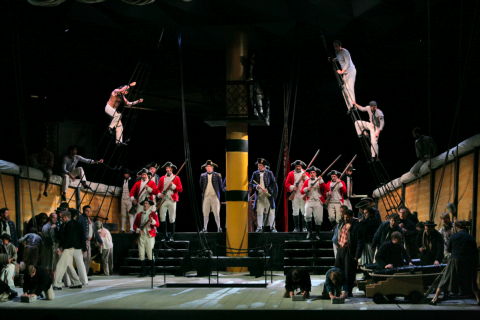
A scene from Britten's 'Billy Budd' at Santa Fe Opera. Photo © 2008 Ken Howard
|
Several apprentices added their considerable talents to the mise-en-scène. They were: tenor Jeffrey Behrens and baritones Matthew Hanscom, Chad Sloan, Kelly Markgraf, Arthur Jones and Stephen Hartley. This show painted a stark picture of man's inhumanity to man but made it palatable with beautiful singing from many fine artists.
Radamisto is a work by George Frideric Handel with a libretto by Nicola Francesco Haym. The story, which had been used in opera before, comes from an incident recorded by the Roman historian Tacitus. Handel's piece was first performed in London at the King's Theatre, Haymarket, on 27 April 1720. The version performed on 7 August at Santa Fe Opera was close to the one heard at the première.
The creative team of director David Alden and designer Gideon Davey provided a great deal of 'eye candy'. The backgrounds were colorful, sometimes reflective, and the costumes extraordinarily inventive. The women who sang female roles were swathed in what looked like silks, while most of the male characters were garbed as oriental potentates. The one exception was Tigrane, sung by the usually alluring Heidi Stober. She was fitted with a large paunch, ugly glasses and wore an off-white man's suit. Nevertheless, she sang with the lustrous silvery soprano tones we are accustomed to hearing from her.
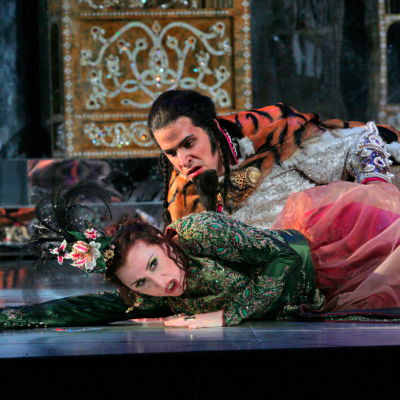
Laura Claycomb as Polissena and Luca Pisaroni as Tridate in Handel's 'Radamisto' at Santa Fe Opera. Photo © 2008 Ken Howard
|
As Tiridate, King of Armenia and the covetous villain of the piece, Luca Pisaroni showed his versatility. The jovial Figaro of two nights before had become a tyrant who sang the most intricate Handelian ornamented lines while threatening, and sometimes committing, mayhem. Laura Claycomb, the Polissena, also excelled at this music while she lamented her fate as the king's unloved wife. Kevin Murphy was a moving figure as the elderly King Farasmane of Thrace.
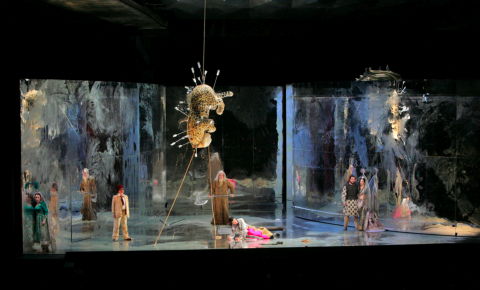
Act II of Handel's 'Radamisto' at Santa Fe Opera. Photo © 2008 Ken Howard
|
The raison d'être for this production was star counter-tenor David Daniels and he most certainly did not disappoint his fans. He sang with dulcet tones. Deborah Domansky, who took over the role of Zenobia from Christine Rice, sang with artful coloratura phrasing and looked enchanting in an open midriff costume that few other singers would dare.
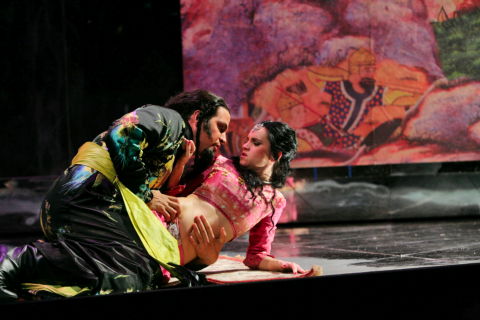
Luca Pisaroni as Tridate and Deborah Domanski as Zenobia in Handel's 'Radamisto' at Santa Fe Opera. Photo © 2008 Ken Howard
|
Making a modern orchestra sound like something out of the eighteenth century is not an easy task, but Harry Bicket accomplished it for these performances. His solo instrumentalists played with tonal and rhythmic accuracy while the rest of the group sounded as though they were playing on authentic antique instruments. Memories of this performance will be treasured for a long time.
The last of the Santa Fe productions was Kaija Saariaho's Adriana Mater, which had already been seen in France and Finland but was brand new to American audiences. The libretto of this anti-war piece is by Lebanon-born writer Amin Maalouf, who had once been a war reporter. Thus, he has had first hand experience with the effects of conflict on inhabitants of the countries involved. This reviewer attended the performance on 8 August, the day the conflict began between Russia and Georgia!
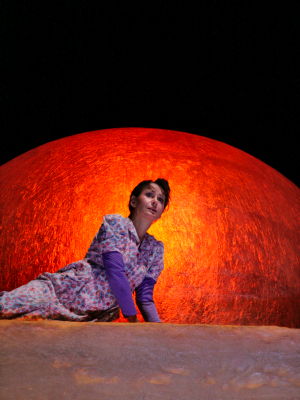
Monica Groop as Adriana in Kaija Saariaho's 'Adriana Mater' at Santa Fe Opera. Photo © 2008 Ken Howard
|
Saariaho's music for this opera is more dramatic than her score for her earlier Santa Fe work, L'Amour de Loin, and the result is a mellifluous resplendence we had not heard from her before. Conductor Ernest Martinez Izquierdo brought out a wide variety of sound levels, making the audience realize how much can only be experienced at a live performance.
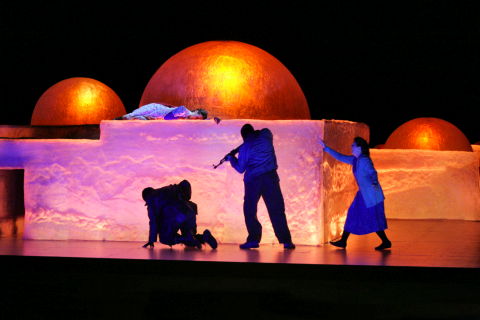
Monica Groop as Adriana (top) and (from left to right) Matthew Best as Tsargo, Joseph Kaiser as Yonas and Pia Freund as Refka in Kaija Saariaho's 'Adriana Mater' at Santa Fe Opera. Photo © 2008 Ken Howard
|
The stage picture by scenic designer George Tsypin was rather plain, involving only buildings with domed roofs that were sometimes colored by James Ingalls' inventive lighting. Director Peter Sellars had his characters move in realistic style and their story was readily understandable. The costumes by Martin Pakledinaz were reminiscent of the World War II era.
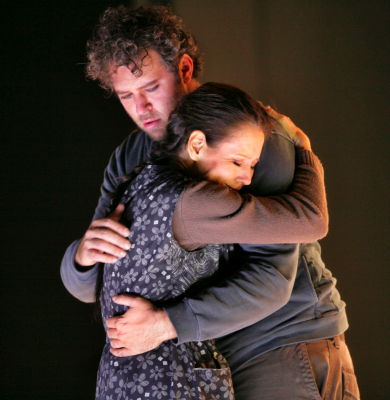
Joseph Kaiser as Yonas and Monica Groop as Adriana in Kaija Saariaho's 'Adriana Mater' at Santa Fe Opera. Photo © 2008 Ken Howard
|
Monica Groop was a most moving Adriana. She captured the affection of the audience with her resplendent singing and lit up the stage with her charisma. As Tsargo, the villain, Matthew Best was an intensely dramatic figure who became more sympathetic as the story unfolded. Soprano Pia Freund was a stunning Refka and tenor Joseph Kaiser gave a passionate performance as Adriana's son, Yonas. It's always a joy to watch a new opera unfold. Hopefully this one has some staying power. Santa Fe had been a wonderful experience and as it ended one began to look forward to the next season in this unique operatic setting.
Copyright © 17 August 2008
Maria Nockin, Arizona USA

The Santa Fe Opera season continues until 23 August 2008 with four of the five operas reviewed. Following an apprentice showcase (fully-staged opera excerpts featuring young talent) tonight (17 August 2008) at 8.30pm, there are performances of The Marriage of Figaro (Monday 18 and Friday 22 August 2008), Falstaff (Tuesday 19 and Saturday 23 August), Radamisto (Wednesday 20 August) and Billy Budd (Thursday 21 August 2008), all starting at 8pm. Details at www.santafeopera.org or +1 (505) 986 5900 / (800) 280 4654. The 2009 Santa Fe Opera season, from 3 July, will feature performances of Verdi's La traviata (3, 8, 11, 17, 24 July and 4, 11, 17, 22, 26, 29 August), Mozart's Don Giovanni (18, 22, 31 July and 8, 13, 21, 24, 27 August), Donizetti's The Elixir of Love (4, 10, 15 July and August 6, 12, 20, 25, 28 August), Gluck's Alceste (1, 5, 10, 14, 19 August) and the world première of The Letter with music by Paul Moravec and a libretto by Terry Teachout (25, 29 July and 3, 7, 15, 18 August). Read M&V reviews of Rameau's Platée and Tan Dun's Tea, a Mirror of the Soul, La bohème and Così fan tutte, Richard Strauss' Daphne, Richard Strauss' Salomé, Mozart's The Magic Flute and Bizet's Carmen at previous Santa Fe Opera seasons. |
|

